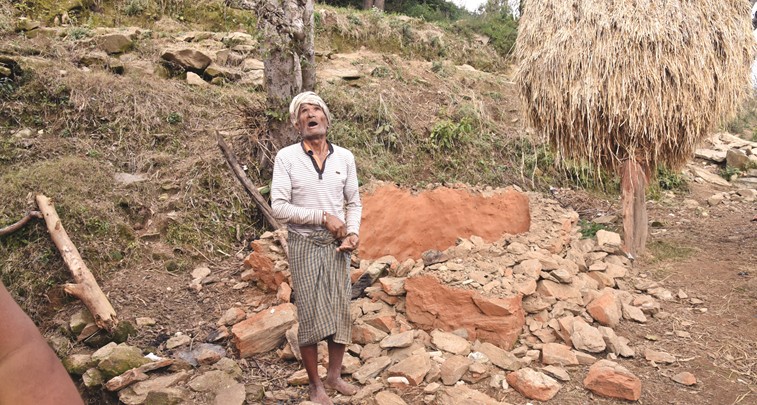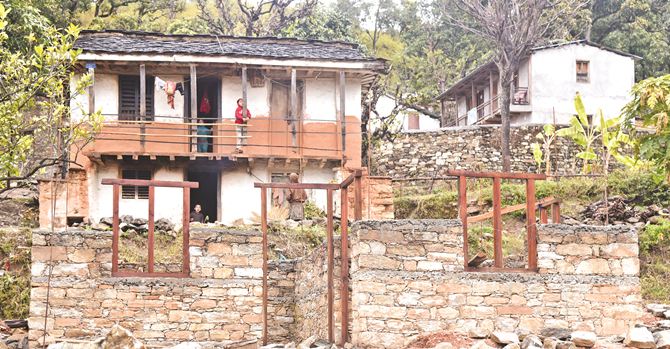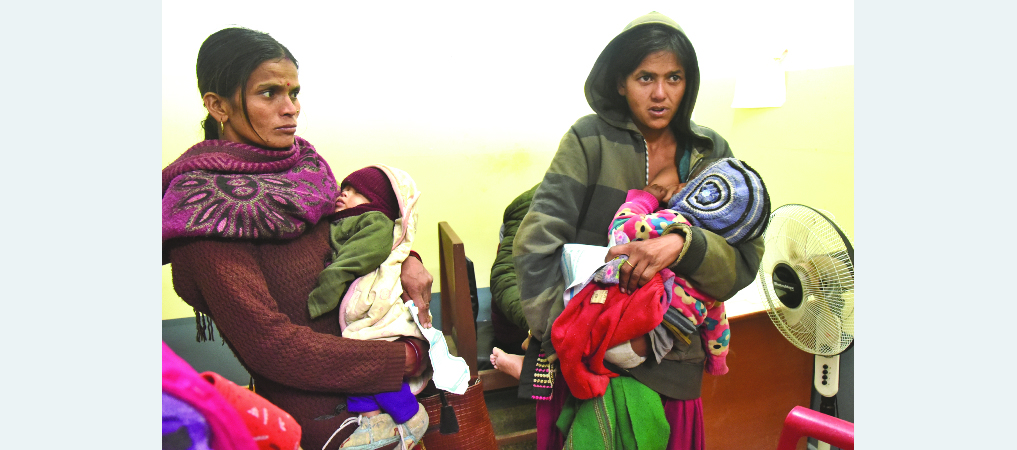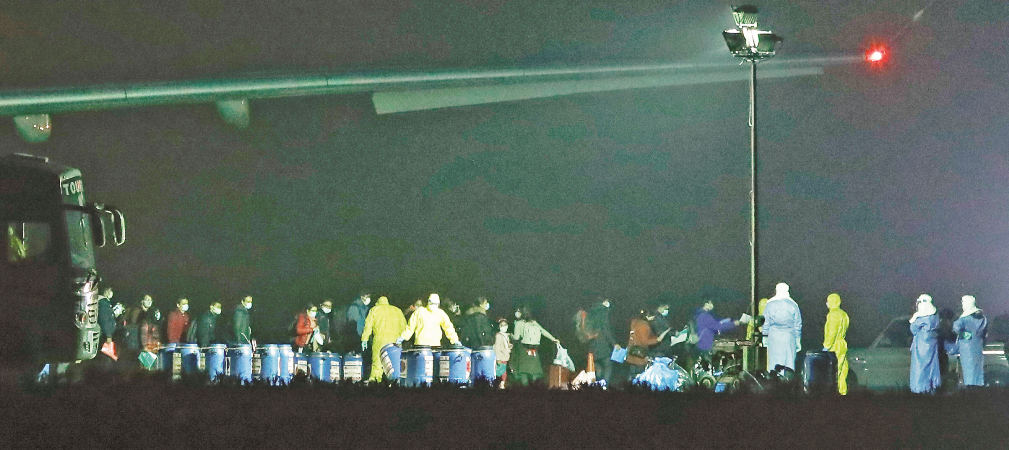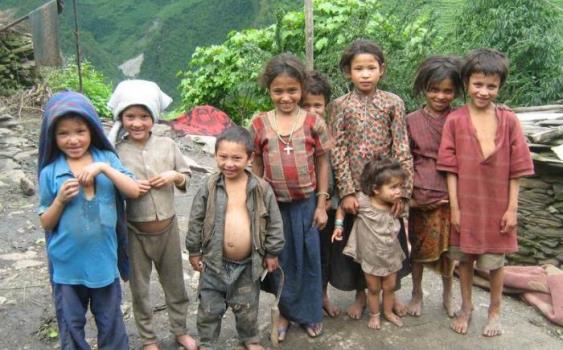COVID-19 :
A Desperate Wait For Vaccines
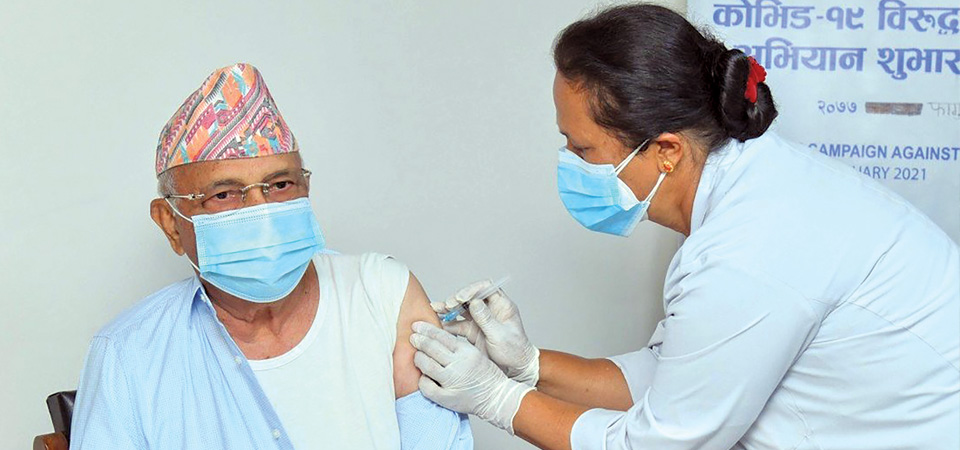
Ajita Rijal
With the third wave of the coronavirus pandemic threat hanging over us like a Damocles' sword, our nation's desperate wait for the COVID vaccine shows no sign of subsiding at present, impeding our authority in achieving its desired vaccination campaign goals. The inoculation of entire population in a phase-wise manner against the dreadful contagion is key to end the COVID-19 pandemic.
Though there is some respite lately in the daily caseloads of COVID-19 that spurred the authority to relax its restrictive orders, the supply of the coronavirus shots to the country has almost stopped. The government has made its frantic efforts and pleas to various vaccine-manufacturing countries to procure the vital jabs.
More than 6,000 people have lost their lives to the virus over the past 11 weeks ever since the second wave of the pandemic gripped the nation, compelling the authorities and people to realise the vital fact that vaccines are the only way to fight and defeat the virus.
The COVID-19 Vaccines Global Access (COVAX) facility, an initiative established by the World Health Organisation (WHO) in collaboration with Global Alliance for Vaccines and Immunizations (GAVI) and Coalition for Epidemic Preparedness Innovations (CEPI) has delivered a ray of hope for the countries like ours. The WHO under its COVAX facility has planned to inoculate twenty per cent of the world populations living in the 92 poorer countries including Nepal. However, the WHO is facing a great challenge in conducting immunisation as per its scheme owing to the short supply of Covishield vaccines by India to the COVAX facility.
Government’s Plans and Effort
Nepal started its first vaccination campaign early this year in January after the much-awaited COVID-19 vaccine arrived in Nepal in the last week of January. The first phase of the 10-day nationwide vaccination drive was conducted from January 27 to February 6. During 10 days, a total of 1,84,745 people got the jabs across the country. The number was only around 43 per cent of the originally planned figure. Everyone, including government employees, health experts and workers were excited with the availability and arrival of the vaccines much before the expected time in Nepal. However, once the inoculation kicked off, it appeared that even health workers and other frontliners seemed to lack confidence in the vaccines. The importance and efficacy of the vaccine were highly identified after the second wave of COVID-19 in mid-April.
When Nepal kick-started its first phase vaccination on January 27, Prime Minister KP Sharma Oli had declared that all Nepalis would be inoculated within three months. Later assuring the citizens, PM Oli had also said that if the vaccines are available within time, the government could vaccinate its entire population within 2021. There were high hopes for vaccines and positive vibes all around and the situation did not look grim then. Nepal had become one of the first countries to roll out vaccines against COVID-19 even as many other countries were struggling. Nepal was then much hopeful with a big respite that it would get enough vaccines from neighbouring India, the world’s largest vaccine maker.
The government has planned a plan to vaccinate up to 72 per cent of its population above 18 years of age, as part of the COVID-19 national vaccination response. Children up to 14 years, who form 28 per cent of the country's total population, are currently not part of the government's COVID-19 vaccination plan.
While presenting the budget for the upcoming fiscal year 2021-2022 recently, Finance Minister Bishnu Prasad Paudel said that the government was committed to providing free vaccines against COVID-19 to all its citizens, for which Rs.26 billion has been allocated for procurement of vaccines. The government has set aside funds to purchase vaccines, and both the World Bank and Asian Development Bank are providing funds as well, so funds are not currently a problem while the supply is.
The government is expecting support from the COVAX facility. As per the commitment of the COVAX facility, it will facilitate vaccines sufficient to 20 per cent population. As more vaccines are needed to be procured for the rest of the population as well as those eagerly waiting for the second dose, the government must adopt multiple alternative strategies.
Nepal has successfully demonstrated a rapid rollout of COVID-19 vaccination. However, uncertainty regarding supplies and shortage of vaccine doses remain a challenge to quickly vaccinating the entire targeted populations. Amid criticism for its failure to reach out to other countries for the COVID-19 vaccines, the government has also activated multiple channels- official and diplomatic–to acquire vaccines from China, Britain, Russia and United States.
"An utmost effort from various mechanisms is underway to bring the vaccines," said Dr Jhalak Gautam, Chief of the National Immunisation Programme under the Ministry of Health and Population (MoHP). The government is committed to vaccinating all the eligible people free of cost and it has been exploring all possible ways to procure vaccines at the earliest, he added.
Going by last year’s swift action, as soon as vaccines were available, the government approached manufacturers and international agencies. The then Foreign Minister, Pradeep Gyawali, had said that the government was looking for affordability, efficacy, and the logistics for refrigeration of vaccines. AstraZeneca’s Covishield vaccine became the choice of Nepal considering its storage and price factors. After it arrived in Nepal, the first doses were administered to people in large numbers, and the hope then was that the procurement of additional doses would not be a problem.
Unfortunately, when the second wave of the pandemic spread in India in March, they stopped their vaccine exports. With this, as there was a slim chance of getting additional doses from India, which was itself struggling to vaccine its citizens, the government approached other countries like the UK, China and Russia about procuring vaccines. The government has been asking America for help, which has bought large doses of AstraZeneca shots.
Lately, in addition, the government is also getting commitments from the COVAX facility. The UK has offered to give two million doses of AstraZeneca to the country. The USA has also announced that it will provide seven million vaccines for Asian countries, including Nepal.
Dr Shyam Raj Upreti, Coordinator of COVID-19 Vaccine Advisory Committee at the MoHP, said, “ The nation has been trying to import vaccines from everywhere. We have also been following up on the one million doses of Covishiled, which the government bought from India. However, as India itself has been hit hard by the pandemic and is in the middle of its largest vaccination campaign, delivery of vaccines from India is all but uncertain for now.”
“Also, the President has written to her counterparts in various nations seeking aid in making vaccines available for the country. In response to her letter, the USA has also committed to providing some amount of vaccines to Nepal under the COVAX facility. As soon as we receive the aid, we will start providing the second dose to those aged above 65," said Dr Upreti.
Major Challenges
Supply is the biggest challenge faced to scale up the COVID-19 vaccination campaign globally. There are simply not yet enough vaccines to meet the overwhelming global demand. The richer countries that ordered the vaccine earlier and signed agreements to purchase billions of vaccine doses have held almost all of the supply. Since they purchased vaccines several times more than their populations require, the countries with lower incomes like Nepal have been hit hard by vaccine shortages.
With the onset of the second wave of the COVID-19 pandemic, Nepal has lost many lives. To break the chain of infection and stop fatality, the vaccine is only the way out. Health experts have predicted that the country might face a crisis if the third wave of the pandemic hits us. The developed nations that contributed and produced vaccines are giving priority to their citizens.
Meanwhile, vaccine procurement seems to be affected by lethargy and the current unstable politics. Although our government is repeatedly saying that it was working to procure life-saving vaccines, health experts have claimed that Nepal has not been receiving vaccines due to an unstable government.
The government must use all the current and alternative options and possibilities to procure appropriate vaccines and ensure that all the citizens are vaccinated at the earliest.
Nepal's Vaccination Campaign
With high hope and enthusiasm, Nepal launched its vaccination campaign against COVID-19 on January 27 using 1 million doses of Covishield, India had provided under its Vaccine Maitri Programme. Around 430,000 frontline workers- health workers, staff at health facilities, female community health volunteers, security personnel, sanitation workers – were listed as priority groups for the first round of the vaccination campaign.
After the first round’s first phase was completed, the government vaccinated journalists and diplomatic staff. When the first phase was completed on March 5, as many as 438,000 people had received their first doses of COVID vaccines. In February, the government decided to buy 2 million doses of vaccines from the Serum Institute of India, at $4 per dose. The first consignment was delivered immediately, as 1 million doses arrived on February 21 but the second consignment has not arrived yet.
Likewise, another 348,000 doses of Covishield arrived in Nepal on February 21 under the WHO’s COVAX facility. India had separately provided 100,000 doses for the Nepal Army.
With the continuous arrival of vaccines, there were high hopes among the public that they would receive the vaccines within the stipulated time. The government inoculated 1.4 million senior citizens in the second phase of the vaccination campaign. But then, the second wave of COVID-19 gripped India from March which led it to ban the export of vaccines and the Serum Institute stated its inability to provide further vaccines to Nepa. The institute had asked Nepal to find other vaccines in the place of its Covishield.
After Nepal granted emergency use approval to the Vero Cell vaccine of Sinopharm of China, on February 15, the Chinese government provided 800,000 doses of the vaccine under grant assistance. The Vero Cell arrived in Kathmandu on March 29.
With the Chinese vaccine, the government resumed the vaccination campaign from April 7. Vero Cell was then administered to the people working in postal and telephone services, public transportation services, water supply and distribution, tourism sector—hotels and restaurants— production, sales and distribution of medicines, electricity supply, storage and transportation of consumer goods as well as health workers who had missed the first phase of the vaccination drive earlier from January 27. They were provided with the second dose of Vero Cell from May 16 to May 25.
The country resumed its stalled COVID-19 vaccination campaign early this month on June 8 with 1 million doses given by China after the government made international pleas for help. The government decided to inoculate people aged 61-64. Having an insufficient amount of vaccines, some of the local levels provided jabs to the people aged 62- 64 years of age. MoHP has announced to provide the second dose of Vero Cell from July 6.
The government has been so far able to vaccinate about 8.3 per cent of the population with the first dose. Among them, 2.4 per cent have received both doses and are fully inoculated so far. According to Dr Jhalak Gautam, a total of 2,599,553 people have received the first dose of the jab while 754,542 people have received both doses so far.
Also, as per the COVAX commitment, 1.9 million doses were due to arrive in Nepal by March. However, as per the latest update made by the COVAX, an additional 348,000 could come by July. More than 1.4 million senior citizens received their first Oxford-AstraZeneca doses of the Covishield vaccine in mid-March. When the vaccine supplies delayed, the government is compelled to extend the window for a second dose to 16 weeks. Still, vaccines have not arrived from any of the channels.
Unequal Distribution
According to Kaiser Family Foundation (KFF), an American non-profit organisation working on health policy analysis, high-income nations already have contracted more than half of the doses of COVID-19 vaccines, while low-and middle-income countries have access to only enough vaccine doses to cover approximately one-third of their populations.
In order to tackle the issue of inequitable distribution of vaccines, WHO started the COVID-19 Vaccines Global Access (COVAX) Facility in association with a few partners.
The COVAX facility aimed to bring the nations together for vaccine procurement and distribution, regardless of their income or contributions to the development of vaccines. It was a major step regarding the equitable distribution of vaccines globally. A month earlier, on May 29, former Foreign Minister Pradeep Kumar Gyawali had said that though the government has allocated an adequate budget to procure the vaccines, the availability of vaccines has been delayed because of unequal distribution of vaccines around the world. Back then, former minister Gyawali had said that there would be a 'breakthrough' conclusion within 15 days, as some of the countries have declared to provide vaccines as assistance. But all those promises are not fulfilled yet.
Global organisations such as GAVI and CEPI are working for an equal distribution of vaccines as they said the pandemic will not go away unless everyone is vaccinated around the world.
Importance Of Jabs
Various studies have shown that vaccines are the safest way to keep COVID-19 at bay. To get rid of the life-threatening virus, a vaccine against it is a must. Vaccines are important in the battle against COVID-19, and getting vaccinated is one of the best ways to protect yourself and others from COVID-19.
Dr Rabindra Pandey, a public health expert, said that as the second wave of COVID-19 was more fatal than the first wave, people who have taken double shots have not fallen ill seriously from the virus.
Even deaths were not recorded among the people who received both doses of the vaccine, said Dr Pandey and emphasised the need to ensure availability of vaccines at the earliest.
According to the WHO, vaccines train our immune system to recognise the targeted virus and create antibodies to fight off the disease without getting the disease itself. After vaccination, the body is ready to fight the virus if exposed to it, thereby preventing illness.
Most people who are infected with SARS-CoV-2, the virus that causes COVID-19, develop an immune response within the first few weeks, but various studies and researches are still going on to learn how strong and lasting that immune response is, and how it varies between different people.
WHO emphasised that people who have already been infected with SARS-CoV-2 should still get vaccinated unless told otherwise by their health care provider. Even if you have had a previous infection, the vaccine acts as a booster that strengthens the immune response. There have also been some instances of people infected with SARS-CoV-2 a second time, which makes being vaccinated even more important, according to WHO.
(Rijal, a journalist with this daily, writes on health issues)
Recent News

Do not make expressions casting dout on election: EC
14 Apr, 2022
CM Bhatta says may New Year 2079 BS inspire positive thinking
14 Apr, 2022
Three new cases, 44 recoveries in 24 hours
14 Apr, 2022
689 climbers of 84 teams so far acquire permits for climbing various peaks this spring season
14 Apr, 2022
How the rising cost of living crisis is impacting Nepal
14 Apr, 2022
US military confirms an interstellar meteor collided with Earth
14 Apr, 2022
Valneva Covid vaccine approved for use in UK
14 Apr, 2022
Chair Prachanda highlights need of unity among Maoist, Communist forces
14 Apr, 2022
Ranbir Kapoor and Alia Bhatt: Bollywood toasts star couple on wedding
14 Apr, 2022
President Bhandari confers decorations (Photo Feature)
14 Apr, 2022



